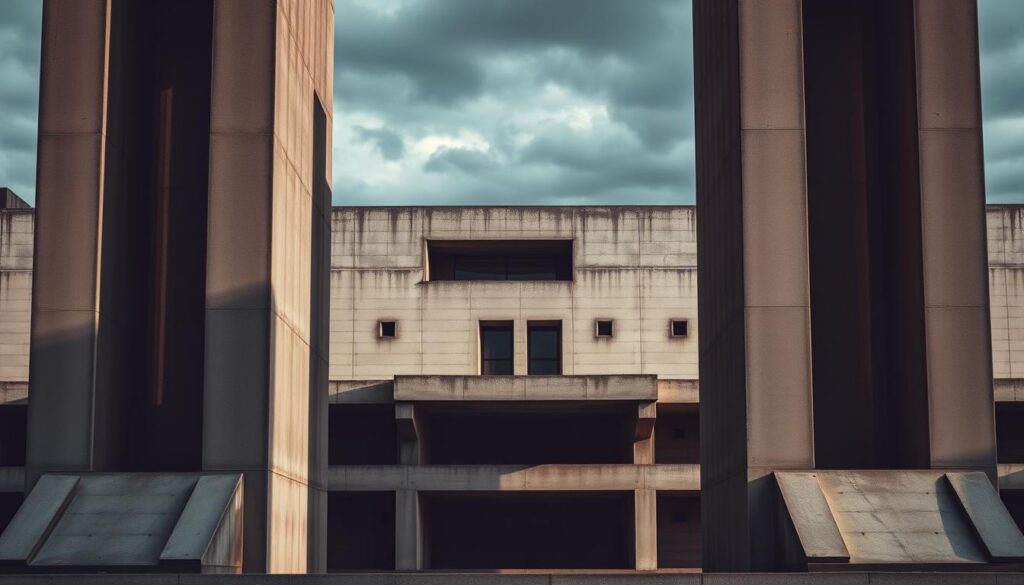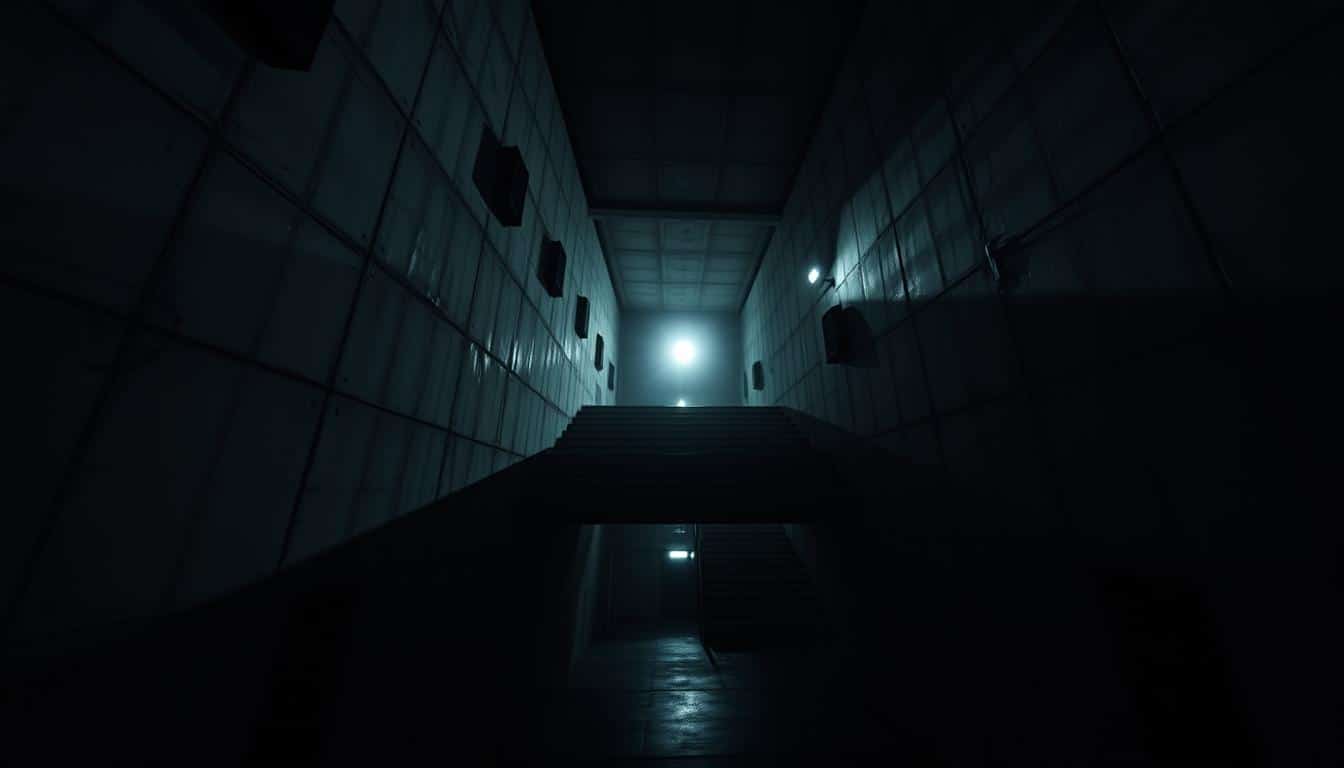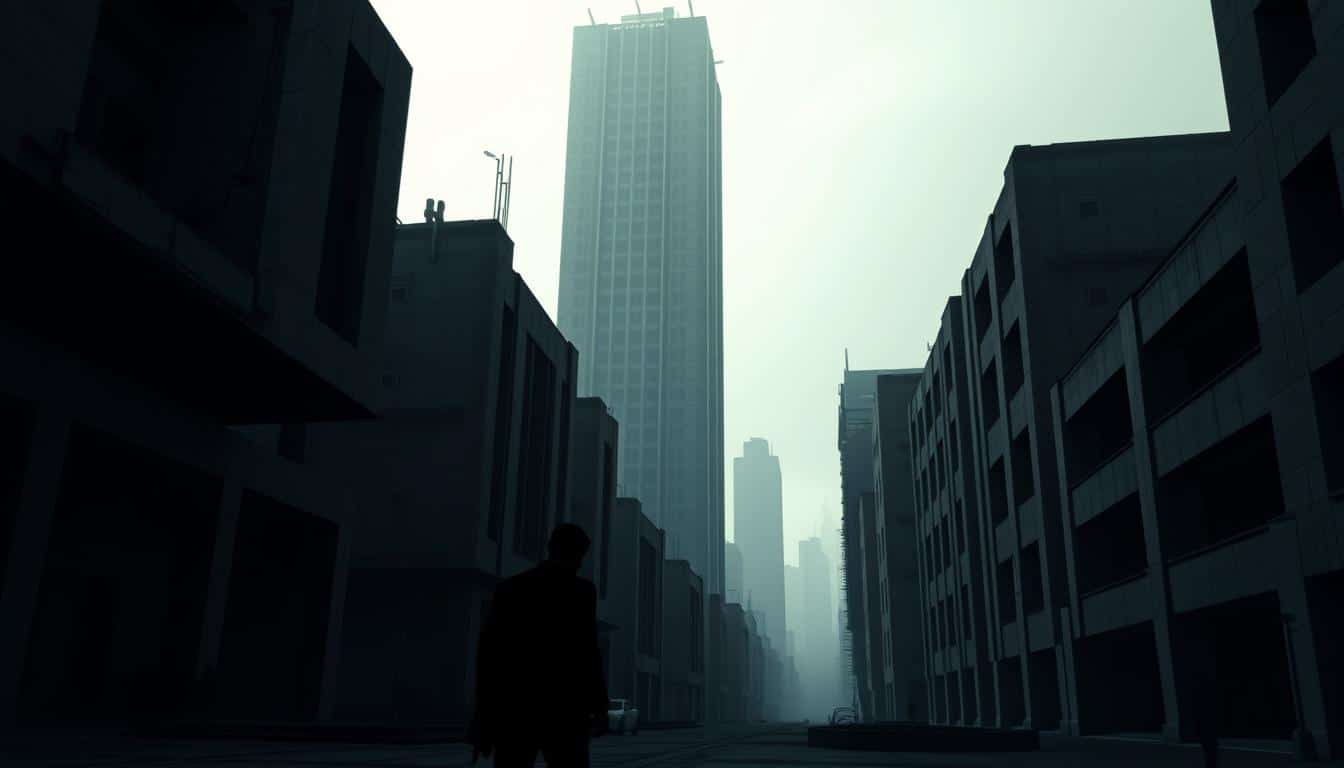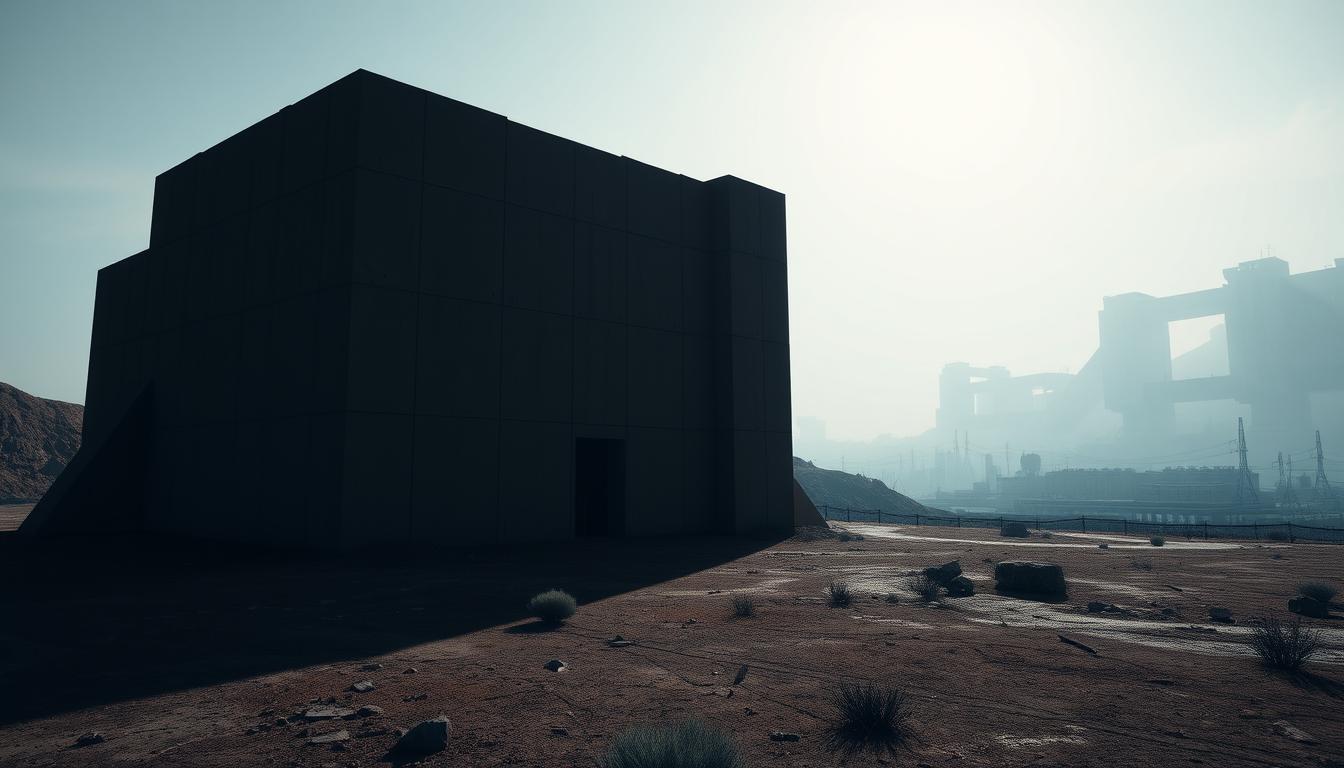Brutalist architecture, known for its bold shapes and raw concrete, deeply affects a game’s atmosphere. By using Brutalist elements, game creators craft worlds that pull strong feelings from players, making the game more engaging. This architectural style’s coldness and toughness not only set the visual scene but also influence how players feel.
As Brutalist designs become key to a game’s story and visual style, they create unique settings. These settings strike a chord with players, adding to their experience.
Introduction to Brutalist Architecture
Brutalist architecture is known for its strong, raw look. It plays a big role in architecture history. The term “definition of Brutalism” includes how it looks and its importance in culture. It shows what society values and its historical trends.
This style uses materials like raw concrete and modular shapes, putting function first.
Defining Brutalism in Architectural Terms
This architecture style is all about being simple and bare. It moves away from fancy details. Designed to show its structure and use, it reflects a truth in its materials and shapes.
The frequent use of concrete makes buildings stand out, giving them a unique look in cities.
The Historical Context of Brutalist Architecture
Starting in the late 1940s, Brutalism was a change from earlier, more elaborate designs. Architects wanted to make spaces that were useful for society after the war. They focused on making practical spaces during rebuilding times.
This style became popular quickly, affecting many kinds of buildings, from government places to houses. Brutalist design has kept changing, staying relevant in architecture talks and even video games.

Characteristics of Brutalist Design
Brutalist architecture stands out with its own special qualities. It shows off a bold, raw look and a strong emotional feeling. The impact it has comes from its distinct features and the materials used in construction. Learning about these aspects reveals Brutalism’s unique viewpoint.
Common Features and Materials
Features of Brutalist design include:
- Heavy use of raw concrete, often left as is
- Modular forms that bring unity through repetition
- Exposed structural parts, showing off the building’s structure
- Bold geometric shapes that stand for strength and stability
Materials in architecture greatly define Brutalist style. Concrete is the main player, but steel, glass, and brick add contrast. These materials give buildings a lasting, individual character.
The Philosophy Behind Brutalist Architecture
The thinking behind Brutalism goes beyond just looks. It views buildings as powerful, separate beings that interact with their environments. Brutalism focuses on function over decor. This simple style believes architecture must be useful, serve its people, and yet keep its artistic side.
The Role of Brutalist Architecture in Creating Game Atmosphere
Brutalist architecture has a big impact on game atmosphere. It pulls players into their virtual worlds. The bold and raw designs bring out strong feelings. This helps create a gaming environment filled with power and deep thought. The special features of brutalist style make games unforgettable and powerful.
Evoking Player Emotions through Design
Using brutalist principles in game design connects players emotionally to the setting. The simple, heavy designs can make players feel amazed or unsettled. They move through these spaces, feeling the presence of large structures. This kind of design adds depth to the story, making the game more enriching. It also makes players think more about their role in the game world.
Creating a Sense of Place in Virtual Worlds
Brutalist elements help game makers create realistic environments. Each space feels real and invites players into a special kind of reality. These settings work as both backgrounds and part of the story. They help with storytelling and character growth, while also encouraging players to explore. The feel of these places sticks with players, even after they’ve finished playing.
Influence of Brutalism on Game Environments
Brutalism in video games leaves a big mark on game design. It does this through stark environments that boost story-telling. John Carpenter’s filmmaking adds a sense of isolation and eerie feelings, which fit well in game design. This connection lets players dive into worlds that mirror Carpenter’s look and feel.
John Carpenter’s Narrative Style and Game Design
John Carpenter’s movies often create emotional scenes that look like brutalist architecture. His stories bring up feelings of unease and deep thought. They lay the groundwork for captivating video game experiences. The design choices in some games are inspired by his work. They use design ideas that focus on being alone and bleak, just like Carpenter’s stories.
Examples of Brutalism in Modern Video Games
A lot of today’s video games use brutalism as a key part of their world creation. Games like Control and Dishonored show how brutalist design adds to gameplay and story. They present a raw architectural style that influences how players feel. This creates a tense and psychologically charged environment. Using brutalism not only looks good but also adds layers to the game’s story and challenges.
Case Study: NaissanceE and Its Architectural Inspirations
NaissanceE has a unique style that is inspired by brutalist architecture. It pulls players into a big, emotionally deep world that feels both open and empty. The game’s design focuses on simple shapes and lines, which makes exploring more interesting.
Architectural Techniques Used in NaissanceE
The game uses certain architectural methods:
- Simplistic shapes bring order to the chaos.
- Concrete textures remind us of Brutalism.
- The layout makes players want to see everything, encouraging them to explore.
Emotional Responses to NaissanceE’s World Design
When playing NaissanceE, many feel deep emotions because of its simple yet stark landscapes. Here’s how the architecture affects players:
- The big spaces make you feel wonder and a desire to explore.
- Elements that contrast with each other arouse excitement and nervousness.
- The simple design makes players think deeply, improving the game experience.
Brutalism in Major Game Titles
Brutalist architecture is key in defining the look and feel of big games. Games like Control, Dishonored, and Wolfenstein use architectural elements well. They add to the storytelling and create unique worlds.
Control and the Oldest House
The Oldest House in Control is a prime example of brutalist architecture. It’s a government building known for its bold look and simple colors. It brings out feelings of mystery and power.
This architecture is not just for show. It encourages players to look around and be curious. The design of the Oldest House adds depth to the game. It makes you want to explore its secrets and passages.
The Aesthetic Choices in Dishonored and Wolfenstein
Dishonored and Wolfenstein also embrace brutalism to enhance their art styles. Dishonored mixes 19th-century designs with brutalism. This creates a world that feels both old and new.
Wolfenstein uses brutalism to show a tough and industrial look. This matches its story of fighting back. The architecture in these games deepens the themes. It makes the game worlds essential to their stories.
Exploring the Relationship between Brutalism and Liminal Spaces
Liminal spaces are transitional areas filled with feelings of uncertainty. They exist between defined states in architecture and games, creating emotional landscapes. Brutalism enhances these experiences with its distinct features.
Defining Liminal Spaces in Architecture and Games
Liminal spaces have a unique in-between quality in architecture and games. They appear in places like:
- Hallways
- Elevators
- Empty plazas
- Abandoned buildings
These spots can make us feel nostalgic or disconnected. They serve as a bridge, enhancing our emotional responses.
How Brutalism Enhances Liminal Experiences in Games
Brutalism and liminality come together beautifully in games. Brutalism’s raw geometries create a captivating atmosphere. It makes us question the line between function and deeper questions. This design invites players to explore and reflect on their feelings.
Bringing brutalist elements into games can lead to:
- An increase in emotional engagement
- Promotion of personal reflection during play
- A mix of beauty and discomfort, enriching the liminal feeling
Players venture through these immersive worlds, where brutalism amplifies liminal emotions.
Player Interaction and Exploration in Brutalist Games
Brutalist game design creates a unique way for players to interact. It pushes them to explore deep spaces within the game. This kind of play turns every interaction into an adventure, making gamers think hard about their surroundings.
The Impact of Design on Gameplay Mechanics
Brutalist architecture deeply changes how games work. Its stark and simple designs make players move through spaces with care. This approach draws players into the game, making them search for secrets in the environment. As players move and explore, the game changes, leading to new ways to solve problems and stay hooked.
Levels of Challenge and Player Engagement
Brutalist games offer challenges that keep players coming back. Their complex designs and unique look make players find new ways to win. This high level of challenge makes winning feel great, keeping players interested and eager to play more.
Modern Revival of Brutalism in Video Games
Nowadays, video games are turning to brutalist designs, shaking up traditional gaming looks. Indie games lead this change, showing how bold brutalism can be. Major game studios are paying attention and changing how they design games.
Indie Titles Influencing Mainstream Development
Indie games are leading the way in adopting brutalist designs. Games like “Kairo” and “NaissanceE” show how this style can make games more absorbing. Their simple yet powerful environments have a strong impact on players.
This encourages more game creators to explore bold designs. Even big game companies are starting to use these unique elements in their titles.
The Appeal of Brutalist Aesthetics in Gaming Culture
Gamers are finding the clear, unpolished look of brutalist games refreshing. The authenticity and challenge of these games attract them. As players navigate through simple yet complex structures, they find the gameplay more intriguing.
This shift towards indie games introduces new, creative ways for games to express ideas. It shows how brutalism is leaving its mark on today’s gaming world.
Conclusion
In conclusion, brutalism’s effect on game atmosphere is key in video game design evolution. This style adds emotional depth, drawing players into unique experiences. It lets developers create spaces that stir a broad range of emotions, from wonder to fear.
Looking ahead, using brutalist ideas in games opens new paths for storytelling and player engagement. Brutalism’s raw beauty challenges old design ideas and makes players dig deep into their virtual worlds. This trend is clear in recent games, showing a change in storytelling within games.
Brutalism does more than change how games look; it transforms how players interact with the game world. As games grow, adopting brutalism could lead to new gameplay and stronger emotions, marking its role in future game designs.



